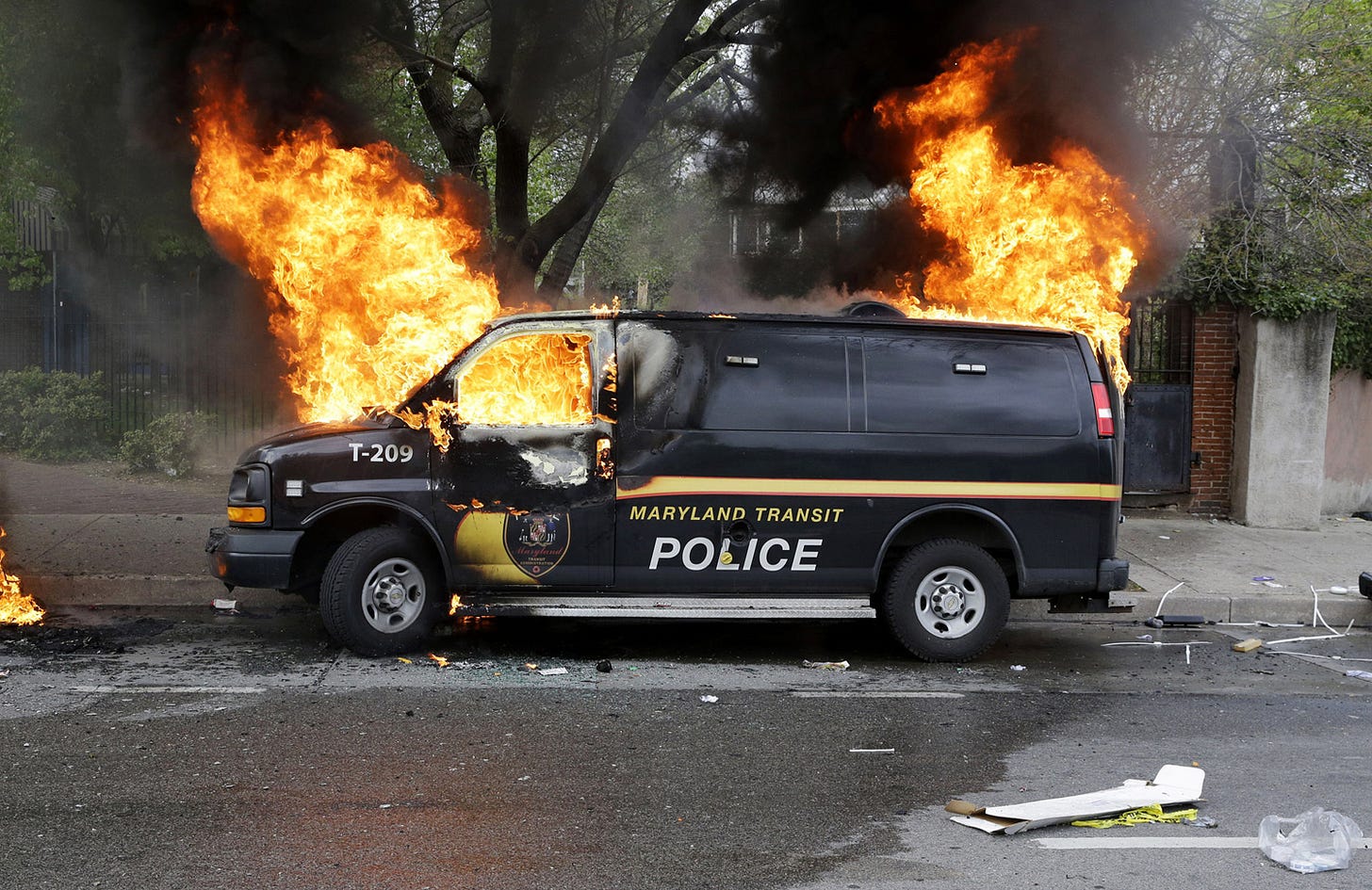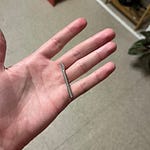Earlier this year, I began working with Natalie Adler of Lux Mag on an essay about the commodification of kink. With the news being what it is—the hits stop coming and they don’t stop coming—that essay swiftly became another, about the intracommunity discourses of kink at Pride. Though a condensed version was sent to Lux subscribers last week, the pub graciously allowed me to share the long one here with you. Gay Wrath Month, indeed.
Like springtime in the Anthropocene, the much-maligned “kink at Pride” (kaP) discourse comes earlier every year, and those of us in the Twitter trenches can’t seem to shake the debate that’s as popular as it is detested. With the demise of Roe v Wade and the rollback on gender, sexual, and racial freedoms it will likely bring; the boom in “no promo homo” legislation restricting the rights of trans people, especially our youth; and spiking trans-antagonism and homophobia, some might see kaP as hair-splitting while the house is on fire.
But rather than distract, kaP marks the spot where moral panics around deviant sex meet America’s queer and trans culture wars. Those queer people who fear public displays of kinky sex, at Pride or anywhere else, often invoke same victim as the fascists do: the straight, cis, white, middle-class, often-feminized abstraction known as the Child. As more privacy-based rights appear on the Supreme Court’s chopping block, including contraception and marriage equality, the anti-kaP crowd would do well to remember that their respectability politics dovetail with far-right agendas to restrict queer rights and eliminate queer lives—and that what constitutes kink, deviant, and even sex are moving targets for our enemies to exploit.
Of course, kaP is much older than Twitter. Since the early days of gay liberation, liberal homos have been eager to collaborate with the state in order to neutralize the danger that radical sexual and erotic freedom—which is demonized by the right as deviance—pose to homosexual assimilation. In his 1982 essay, “Public Sex,” Patrick Califia charts the post-Stonewall history of the white, cis, middle-class gays, and their apologists, who demand that the freaks desist from public sex and cooperate with the cops. “The threat that children might see men having sex with each other is far and away the most popular excuse for surveillance and arrests,” Califia writes. “And it’s possible that a child or a teenager who saw such an act could be frightened, disgusted, or upset. However, that’s not because sex is inherently toxic or traumatic to children. It’s because young people are denied information about sexuality and are kept especially ignorant on the subject of gay and lesbian sex.”1
Of course, as Califia goes on to point out, the Child and children represent two different priorities. If children mattered as much as the Child does, the politicians that call queer people “groomers” wouldn’t be gunning for the forced the genital examinations of child athletes (much less the elimination of subsidized school lunches, or public education entirely). kaP must be understood as the backwash of state efforts to regulate and discipline non-normative genders, a process in which the Child has a long history. The idea that witnessing a certain kind of human sexuality is inherently traumatizing in a way that lack of healthcare, incarceration, or white supremacy is not has recycled and reinforced rhetoric used to criminalize queer people in service of repressive moral panics since at least the emergence of the homosexual as an identity.
In the face of increasing state, media, and stochastic violence against queer and trans people, “respectability” will seem like a safe harbor to those who don’t know, or don’t want to know, that queer, trans, and deviant cannot be separated from each other.
In his introduction to the 2001 reissue of Leatherfolk, journalist and leatherman Mark Thompson writes: “Cultural conservatives, increasingly inhibited from wholesale queer bashing, narrow their target by distinguishing between ‘good’ and ‘bad’ gays, the former being the nice same-sex couple next door, the latter demonized as the perverts in leather on the streets.” If we’re looking to spot the difference between the “good” gays and the perverts ruining Pride, it might help to define our terms.
Expanding on the now-outré S/M or S&M, BDSM stands for bondage and discipline, Dominance and submission, and sadism, masochism, and sadomasochism2. Often used interchangeably with S/M, leather is the legacy of queer sadomasochist subcultures born of American post-WWII veteran and biker clubs bound by a desire to “erogenize the forbidden,” as Thompson puts it. Kink generally refers to non-normative sex; it also can be an umbrella term, one often problematically encompassing leather and BDSM, as well as fetish. All of these terms signify deviant sexual behavior, though deviance itself demarcates a moral and/or criminal element of censure, punishment, and carcerality. Crucially, while today we see “kink” and “BDSM” used to describe a kind of “community,” only leather is a sexual subculture as well as a diffuse but coherent political movement for sexual freedom.
So—let’s break down a few kinky activities and see which are actually deviant, and which are just, you know, gay. Public sex, for example, terrifies the anti-kaP crowd. Nothing LGBTQI about that, right? Except for the queer people who can’t safely be at home or be intimate at home; or the reality for Americans experiencing homelessness, 20-40% of whom are LGBTQI; or outdoor-based sex workers, a trade over-represented by marginal people, including queer and trans people3. Deviance doesn’t account for the material circumstances that make private space difficult or even impossible to attain for those without the money, paperwork, or racial capital. Even with mass criminalization, the housing and debt crises, and rampant inflation rendering “privacy” a luxury good, it’s worth remembering that public sex is a part of queer history for reasons beyond the material and practical: some of us simply want to fuck somewhere other than where we sleep without that being used as a pretext for our criminalization4. As Dorothy Allison once wrote, “There is this notion that sex is separate from life.”
What about gender play, with which we as trans people, famously the “T” in LGBTQI, are associated—is that allowed at Pride? Is a cross-dresser daring to appear in the light of day forcing someone else to witness their dangerous kink, and if so, how are we to distinguish them from someone like me, who has made cross-dressing a lifestyle (committed to the bit, as they say)? As the Madison Cawthorn scandal or Proud Boy attacks on drag queens daring to interact with children remind us, gender play is broadly recognized as a fetish, a legacy of pre-Stonewall cross-dressing laws and an echo of newer, intentionally vague legislation, like New York’s “walking while trans” law—used to target trans women, sex workers, undocumented people, and people of color—which was on the books until just last year.
While it’s long been debated whether leatherfolk were actually in attendance at Stonewall, deviant sexuality has always been found at Pride events5. (Incidentally, so have children and youth6, and not just the ones who fought police in the insurrection the parade commemorates.) In 1983, Gayle Rubin wrote that a coherent leather political identity trailed the gay liberation movement by about a decade, when leather organizations began demanding a place at Pride events7. As documented in Coming to Power: Writing and Graphics on Lesbian S/M, the San Francisco lesbian-feminist leather organization Samois struggled to be included at the 1978 Gay and Lesbian Freedom Day Parade (a proto-Pride event). Though they got what they wanted, they were heckled and harassed by the crowd.
Over the past five decades, leatherfolk have made a place for themselves in Pride celebrations, and have created their own, too8. But a bug (or perhaps a feature) of a vague and capacious definition of deviant is that one doesn’t have to be a leatherperson, or even kinky, to be ostracized from LGBTQI functions and organizations—and more crucially, resources earmarked for the same—while being identified as such.
The consensual activities that can supposedly do permanent damage to children, should they accidentally witness them, remain inextricable from the human beings that gay liberation is supposed to be for. If the races, genders, classes, sizes, abilities, and trades that deviate from the white, straight, cis, middle-class, thin, abled, whorephobic norm are among the identity categories viewed as inherently and dangerously sexual, then only the norm can be safe (and when these deviant categories overlap, their vulnerability is only compounded). To say that the deviant subjects produced by white supremacist patriarchy are welcome at Pride so long as they don’t use it to indulge in deviance is to contradict oneself. They’re already deviant because they exist.
Moral panic surrounding the deviance of queer genders is at least as old as the 19th-century Western construct of the (male) homosexual, a legal, medical, and sexological category understood by Europeans as having an intrinsic connection to moral depravity, pathology, or primitivism, depending on where and how in the colonial context he was found9. In the intervening years, moral panics surrounding homosexuality and gender variance (though the distinction between the two is rarely clear) in Europe and its colonies have worked to advance white supremacy, colonialism, and the capitalist expansion of state power. Lately, the homosexual moral panic has been expanded to explicitly include a new emergent sexual identity: trans people10.
Manifested in bathroom bills and legislation equating access to trans healthcare with child abuse, trans people and our accomplices are being targeted as “groomers” of children both in preparation for sexual assault as well as contamination of “cis” children with transsexuality. This not only puts trans adults in danger, but trans children, too; they are condemned as both victims and monsters by everyone from out-and-proud transphobes to The New York Times’ more subtle liberal stooges. As scholars Cassius Adair and Aren Aizura wrote for Transgender Studies Quarterly earlier this year, “Since (some) same-sex sexuality has successfully been privatized and normativized, trans youth now bear the burden of a public, visible social force of ‘sex’ that is imagined to violate the sanctified space of the middle-class nuclear family…If same-sex desire has been domesticated, transness must now represent 'deviant' sex.”
A 21st-century variation on the trusty narrative that we, as queer and trans people, pose moral, emotional, and physical threats to others, kaP both summons and reinforces state violence against anyone identified as deviant. As a popular discourse, it’s framed as a slippery slope into degeneracy: if X is permitted, then Y is inevitable. But it’s no less about the past than the future. Hinging queer and trans civil rights on mutable definitions of privacy, violence, and morality is not new, and the tactical shortcomings of embracing this compromise have been demonstrated again and again (how long before America’s contingent of Buttigieg clones must kiss their precious marriage goodbye?). In tracing its history, we see that kaP discourse is not an aberration, but rather representative of a highly adaptable method of violently imposing norms on queer and trans people by way of the straight superstructure.
Queer opposition to kaP and legislative attacks on trans people—whether directly or by neglect—share analogous logics. kaP is antecedent to and concomitant with legislation meant to “protect” the Child from queer and trans people of all ages. Among these is “Don’t Say Gay”—signed into law by Florida governor Rob DeSantis in late March—which, while outrageous, isn’t groundbreaking in its cruelty. Expanding on the homophobia of its legislative forebears with explicit transphobia, it prevents public school teachers from talking about sexual orientation or gender identity and requires parents to be the first to be notified of any health or support services offered to their kids in school, effectively forcing teachers to out LGBTQI students to their legal guardians.
Supporters of DSG have called it anti-grooming legislation, conflating the acknowledgement of human variety in gender and sexuality with manipulative behaviors used to sexually exploit and abuse children. In a crowded field, it’s among the most prominent current example of right-wing propaganda claiming that the existence of queer and trans people is the equivalent of an unforgivable sexual violence.
DSG joins a fresh paroxysm of anti-gay, anti-trans, and anti-critical race theory legislation. In February, PenAmerica reported that since January 2021, 156 educational gag order bills on speech, behavior, and educational materials have been introduced or prefiled in 39 states. Many use the language of obscenity to discuss these behaviors, while at least one of them, Oklahoma Senate Bill 1142, goes further to reference deviant sex explicitly (italics mine): “No public school district, public charter school, or public school library shall maintain in its inventory or promote books that make as their primary subject the study of sex, sexual preferences, sexual activity, sexual perversion, sex-based classifications, sexual identity, or gender identity or books that are of a sexual nature…” As scholar Ariane Cruz writes, perversion is “a technology of power deployed in the discursive production of sexuality”.11
It’s impossible to talk about the legal status of deviant sex, at Pride or elsewhere, without also talking about the many groups of people marginalized by the law as sexual deviants: not just queer and trans and kinky people, but people of color—particularly black and indigenous people—people experiencing houselessness, disabled people and people with mental illness, sex workers, people who use illegal drugs, and incarcerated and formerly incarcerated people. Deviance is a conceptual place to throw people away, and as the recent escalation of anti-trans sentiment demonstrates, kaP is an outgrowth of a rhetoric with proven results. Its logic hasn’t just infiltrated America’s legal, educational, medical, and military systems—it organizes them12.
What would a Pride parade without kink look like? No puppy masks or leather harnesses, no nudity, and no public sex, which, depending on who’s complaining, could be anything from second base to fisting daisychains—but we’ll leave the details to the lawyers. Of course, cops must be there to ensure no one pollutes our celebration of sexuality with sexuality, their rainbow squad cars bravely defending the sanctity of the Chase floats and Target-branded unicorn swag surrounded by a docile crowd of blood-related, child-laden white families who don’t feel endangered by police. For me, “Is kink allowed at Pride?” smuggles inside another question: “Do we want policing at Pride?”
To protect Pride, we have to protect kink at Pride—kink everywhere, in fact—on its own terms. The alternative is our elimination from public life.
Find me on Twitter. Cop my second novel, X, right here.
From Public Sex: The Culture of Radical Sex (1994)
Citing its entry in Richard von Krafft-Ebing’s Psychopathia Sexualis, which concluded that homosexuality and bisexuality were mental illnesses, Thompson notes, “It is no coincidence that the notion of sadomasochism arose in an identical time and manner as the concept of homosexuality.”
In a 2008 American study, those who lost a job due to anti-transgender bias were almost three times as likely to engage in the sex trade (19.9% vs. 7.7%).
Because straight people do it, too. They’re just less likely to be punished.
Kyle Kingsbury’s “A History of Leather At Pride: 1965–1995” has been a very helpful resource in researching this piece.
“SM Politics, SM Communities in the United States,” The Ashgate Research Companion to Lesbian and Gay Activism
They’ve also reproduced the same structures of oppression that the gay liberation movement has. As scholar Zoé Samudzi writes in “The Chromatics of Play,” “The sexual imaginary within which BDSM is broadly situated is a chromophobic one: it does not organically acknowledge the possibility of the pleasure or interiorities of Black people beyond their instrumentalization in and into white scripts.”
For anyone looking to dig deeper in to this fascinating subject, I recommend the work of contemporary queer and trans scholars like Huw Lemmey and Ben Miller (Bad Gay: A Homosexual History), Jules Gill-Peterson (Histories of the Transgender Child), C. Riley Snorton (Black on Both Sides: A Racial History of Trans Identity), and Leah Tigers (“On the Clinics and Bars of Weimar Berlin”).
In her recent appearance on the Death Panel podcast, Gill-Peterson pointed out that while homosexuality was removed from the DSM in 1973, transsexuality was added in the following edition.
The Color of Kink: Black Women, BDSM, and Pornography
In her analysis of Foucault’s turn toward S&M in Sensational Flesh: Race, Power, and Masochism, Amber Jamilla Musser writes: “S&M reorganizes the body to emphasize pleasure rather than identity or discipline; it offers tangible corporeal freedom.”















